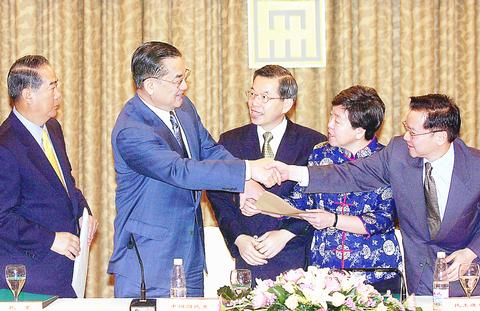Political leaders across party lines yesterday agreed to push for quick implementation of the proposals agreed to at last month's Economic Development Advisory Conference. They also want to promote further inter-party cooperation to help resolve Taiwan's economic problems.
The agreement was reached at a summit of party leaders and groups with deputies in the legislature. The summit was intended as the closing event for inter-party negotiations initiated by the KMT, the majority party in the legislature.
Those attending included KMT Chairman Lien Chan (

PHOTO: FANG PIN-CHAO, TAIPEI TIMES
"Today we've opened a door to inter-party cooperation. Under this atmosphere, we hope that we can further conduct issue-based cooperation to promote national prosperity and stability and the well-being of the people," Lien said.
Under the agreement, the political parties and groups will work to pass 34 pieces of priority legislation in the Legislative Yuan before the legislature is adjourned on Nov. 1 in preparation for the legislative elections.
The 34 items include 20 that are designed to implement the resolutions of the economic conference. The other 14 are aimed at preparing for Taiwan's expected accession to the WTO at the end of the year.
Also, the legislative caucuses of the various parties will set up a monitoring panel to ensure that the executive branch implements the economic conference's proposals in accordance with its targets.
In addition to the substantive measures to improve the economy, the political leaders concurred that other "non-economic factors" that are hampering economic development should be eliminated.
"The parties concerned will continue to push for inter-party amity and cooperation, abide by the constitutional system and build up steady relations between the executive and legislative branches to pursue a long-lasting peace for the country," the agreement stated.
With the prerequisite that Taiwan's national security is protected, the political leaders urged the government to negotiate with China as soon as possible on bilateral issues that are expected to arise after Taiwan's admission into the WTO.
"The authorities on both sides should resolve their differences and resume the cross-strait dialogue carried out by their respective agencies as soon as possible on the basis of the achievement of the 1992 meeting and a subsequent agreement reached in the Koo-Wang meeting of 1993," the agreement said.
The agreement, as soon as it was released, was presented to Premier Chang Chun-hsiung (
Chang promised that the Executive Yuan would implement the consensus of the Economic Development Advisory Conference comprehensively.
"Pursuing reconciliation between the ruling and opposition parties and the ideal of inter-party cooperation, the Executive Yuan will work hand in hand with the Legislative Yuan to work for the economy," Chang said.
While the Executive Yuan is accelerating the pace of legislative drafting so that bills can be sent to the legislature for review as soon as possible, the Council for Economic Planning and Development has been charged with the task of managing and evaluating the progress of implementation, Chang said.
Wang also said that the legislature would do its part, in line with the agreement reached at yesterday's political summit.

TRAGEDY STRIKES TAIPEI: The suspect died after falling off a building after he threw smoke grenades into Taipei Main Station and went on a killing spree in Zhongshan A 27-year-old suspect allegedly threw smoke grenades in Taipei Main Station and then proceeded to Zhongshan MRT Station in a random killing spree that resulted in the death of the suspect and two other civilians, and seven injured, including one in critical condition, as of press time last night. The suspect, identified as a man surnamed Chang Wen (張文), allegedly began the attack at Taipei Main Station, the Taipei Fire Department said, adding that it received a report at 5:24pm that smoke grenades had been thrown in the station. One man in his 50s was rushed to hospital after a cardiac arrest

A car bomb killed a senior Russian general in southern Moscow yesterday morning, the latest high-profile army figure to be blown up in a blast that came just hours after Russian and Ukrainian delegates held separate talks in Miami on a plan to end the war. Kyiv has not commented on the incident, but Russian investigators said they were probing whether the blast was “linked” to “Ukrainian special forces.” The attack was similar to other assassinations of generals and pro-war figures that have either been claimed, or are widely believed to have been orchestrated, by Ukraine. Russian Lieutenant General Fanil Sarvarov, 56, head

SAFETY FIRST: Double the number of police were deployed at the Taipei Marathon, while other cities released plans to bolster public event safety Authorities across Taiwan have stepped up security measures ahead of Christmas and New Year events, following a knife and smoke bomb attack in Taipei on Friday that left four people dead and 11 injured. In a bid to prevent potential copycat incidents, police deployments have been expanded for large gatherings, transport hubs, and other crowded public spaces, according to official statements from police and city authorities. Taipei Mayor Chiang Wan-an (蔣萬安) said the city has “comprehensively raised security readiness” in crowded areas, increased police deployments with armed officers, and intensified patrols during weekends and nighttime hours. For large-scale events, security checkpoints and explosives

PUBLIC SAFETY: The premier said that security would be tightened in transport hubs, while President Lai commended the public for their bravery The government is to deploy more police, including rapid response units, in crowded public areas to ensure a swift response to any threats, President William Lai (賴清德) said yesterday after a knife attack killed three people and injured 11 in Taipei the previous day. Lai made the remarks following a briefing by the National Police Agency on the progress of the investigation, saying that the attack underscored the importance of cooperation in public security between the central and local governments. The attack unfolded in the early evening on Friday around Taipei Main Station’s M7 exit and later near the Taipei MRT’s Zhongshan